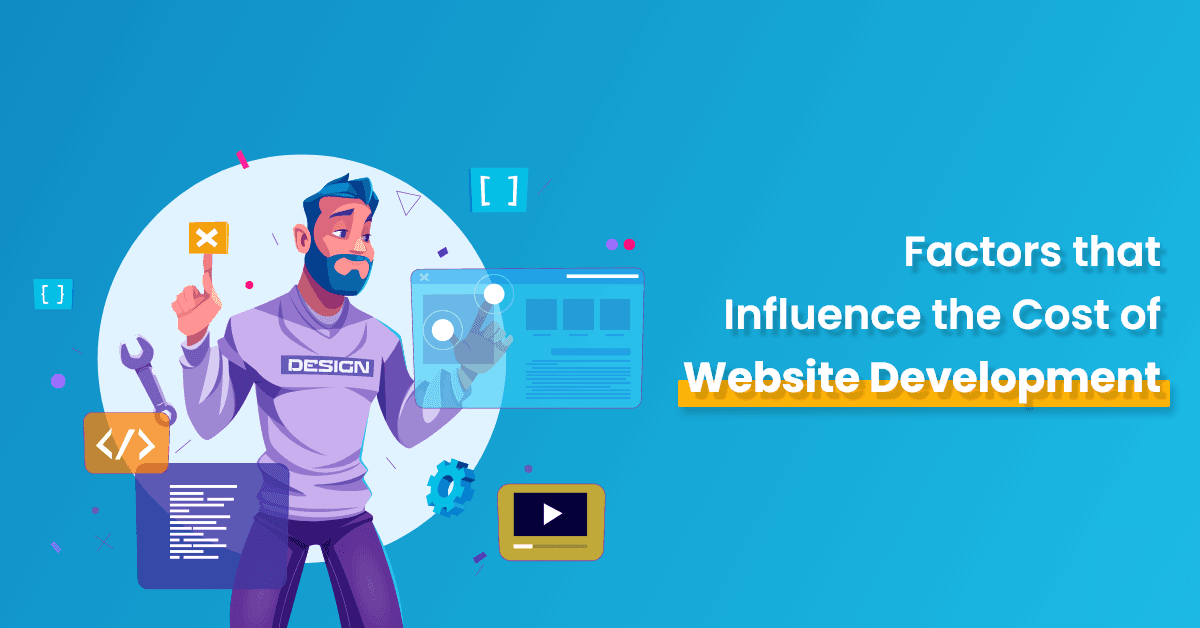
A website is similar to a software program with solid front-end user access. In the simplest terms, a website is just your company’s online storefront. It needs developers’ and managers’ assistance with a complicated backend to provide the website with functionality.
Several factors can affect the e-commerce website development cost. The size, kind, and quantity of goods or services your business sells will affect the price of your e-commerce website.
Numerous people from all around the world can shop at your online store. Building an e-commerce website with a seamless flow, practical functionality, and engaging and responsive to the user to keep their attention, enhance the shopping experience, and maximize the conversion rate.
Here, we have included 15 crucial factors that provide a rough estimate of the cost of a simple e-commerce website.
List of Factors Affecting Website Development Cost
CMS Platform
Your website needs a content management system (CMS) initially. A CMS made explicitly for e-commerce typically offers additional features and functionalities.
An e-commerce platform’s advantages are customized security solutions, shipment integrations, and payment tools. Some characteristics are more robust than others. Your decision could be affected by the variety of products you sell, your sales volume, safety regulations, and add-ons.
Website type
Web development offers a wide range of options. The ideas we take while e-commerce website development or an application differ from those we choose before starting a blog. The most common content management system, WordPress, is likely what you need for a project, including a blog, but for an e-commerce site, someone with expertise in PrestaShop or Magento can fulfill all your requirements. Finally, your organization might need a custom website based on its business plan. When writing code, the developer will have to start from scratch.
Website Design
The general design of a website has a significant impact on its cost.
For instance, a website with static functionality, lesser animation, or no hover effects on your “CTA” buttons will inevitably cost less than a website with dynamic functionality on an animated picture with hyperlinked hover effects.
Moreover, bespoke website design gives you more control over your brand, but the price is proportionally higher.
On the other hand, a website with CTA buttons that have straightforward design functionality may prove to be extremely difficult to construct.
Integrating APIs
An e-commerce website needs numerous API interfaces to be fully functional and to increase its functionality. Examples include integrating social networking for quick login, CRM for customer interactions, Google Analytics for analytical data, etc.
API integrations cost anywhere from $700 and $7,000, depending on the complexity of the integration.
Product and Content Images
The focus of an e-commerce website is the product pages. A simple website may require a few pages, but an e-commerce website demands exceptional, high-quality pages that thoroughly describe each good and service.
Product page pricing varies depending on how many products you sell and how many pages you host. An electronics company, for instance, is likely to provide far more products than a service provider with just a few key offerings.
SEO for Online Stores
A successful website must have SEO so that users can find it on search engines. A website’s copy, images, structure, meta-data, and even its frequency of updating all impact it’s ranking. Because every homepage component is integrated with SEO, it needs help to stand alone. Your website might be approached holistically by an integrated development and design team, which would help to guarantee that everything is fully compliant with e-commerce SEO fundamentals.
Method of payment or shopping cart
An e-commerce website differs from a standard website by offering a shopping cart and checkout options. You can evaluate your anticipated revenues to determine which option is best for your business. Some e-commerce payment platforms, like PayPal or Google Checkout, are initially free to use, but they take a cut of your sales with each transaction.
Making the Final Budget Calculation
All the extra expenses associated with e-commerce website development bring the total to a few thousand dollars. Still, this estimate might range into hundreds of thousands of dollars depending on the size of your website.
Maintenance
E-Commerce platforms require constant maintenance, which includes enhancements, bug fixes, and the installation of new functionality, to keep your store relevant and up to date with the most recent trends. Maintaining an e-commerce website costs between $600 and $12000 each year, depending on how much time a developer invests.
Certificate for SSL
It is crucial to safeguard your website because setting up payment gateways is a requirement for e-commerce companies. So, it is essential to get an SSL (Secure Socket Layer) certificate. You won’t pay much for this; depending on the level of protection involved, prices range from $95 to $500.
Website Safety and Security
If you are planning to launch an e-commerce website, consider how you will verify that a transaction is legitimate and that no one is using stolen credit cards. You must adhere to specific legal standards as a seller because you are dealing with other people’s money and personal information. To avoid getting into trouble later, you must be aware of these before launching your website.
Systems for Integrated Payments
Your website must be safe so that customers feel confident about making purchases. Your responsibility is still to enter the user’s personal information, even though the payment service provider sets up and manages most security measures.
Localized Versions
Translating every page into each of the languages you have chosen is necessary. The number of home, contact and product pages on your website will equal the number of languages. This will raise the number of pages on the website, complicating its structure and increasing the development fee.
Reporting
The additional capability known as “Advanced Reporting” allows you to access statistics about the usage and performance of your website in real-time. This data is automatically organized into your required KPIs and formats, including spreadsheets and CSV.
Such sophisticated analyses give your marketing team strategic insights into what works while saving significant time. Your marketing team cannot rely on multiple technologies for this capability; it can be automated.
However, adding this function to the scope of website construction would incur additional charges.
Domain and Hosting
The variety of solutions available increases the complexity of hosting. It would help if you had a unique domain name to operate any website, and they are typically available for a fair price of $13 to $25. To keep the domain name, you must pay an annual fee. You can go with managed hosting, paying a company to host your website, carrying out regular updates, and fixing bugs.
This is more expensive—between $100 and $250—but it frees you up to concentrate on your company. The alternative is shared hosting, which is less expensive but requires less customization and runs a more significant risk of experiencing delays when visitor volume increases because multiple websites use the same host server.
What is the Ideal Amount You Can Pay for Developing a website?
Constructing an e-commerce website requires several considerations. E-Commerce sites do not have to pay a set price. Depending on your needs, the price will vary. Therefore, it is essential to ascertain the size of your company and the results you desire. If you own a tiny business and your top aim is to sell customers a few things, you may get an essential, low-cost website hosted on Shopify or BigCommerce. Depending on the level of customization, this would cost anywhere from $550 to $1050.
Suppose you want to create a sophisticated, customized store with a wide selection of products, user registration, personalized shopping preferences, and product-driven pricing. In that case, a high-end website will cost you between Rs. $1500 and $6000. Therefore, defining a list of factors is essential before deciding on a price.
Conclusion
Many factors affect the e-commerce website development cost or mobile app. One must update website content and design regularly. Still, you also need to budget for upkeep, especially if the website is essential to your business model.
Meanwhile, hackers are constantly developing new ways to get around security systems. Without intending to be untruthful, let’s not forget that accidents do occasionally happen. Ensure that you are working with a developer who can assist you if necessary.
You can get in touch with developers at WebMob Technologies for any e-commerce website development assistance.
